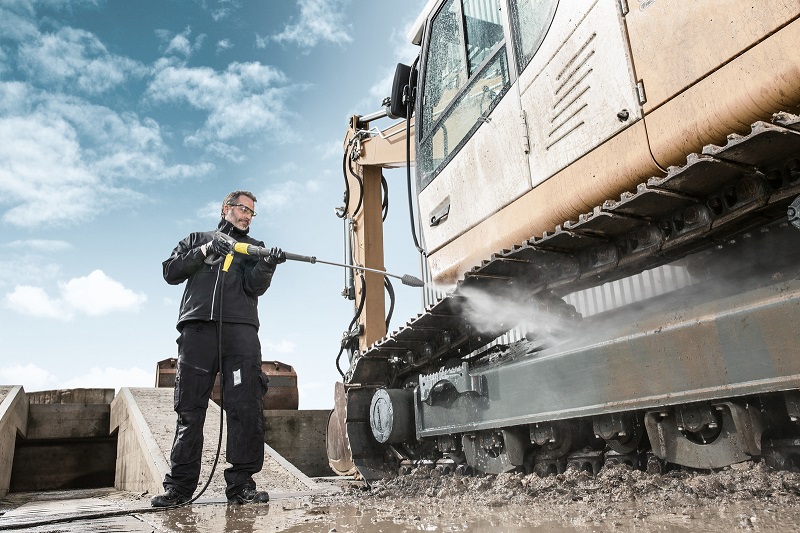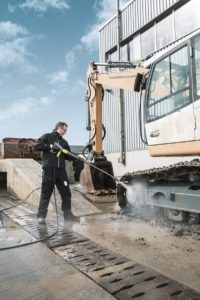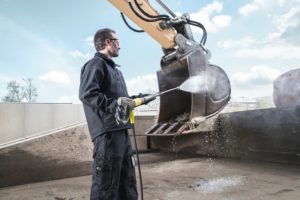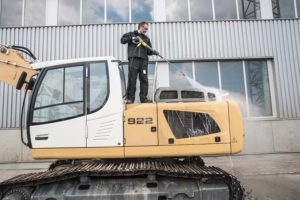
Karcher looks at how careful maintenance of machinery extends its life and usefulness for an efficient and cost-effective site, as well as promoting health and safety.
Functional, future-proof and aesthetic: cleaning construction machines maintains their long-term value and ensures an impressive appearance. Cleaning should be an integral part of construction maintenance processes to ensure efficient operation and machine lifespan. This way, machine damage, the corresponding repair costs and interruption of work, can be avoided.
Of course, now more than ever a hygiene regime that includes effective cleaning measures is crucial. Cleaning plays a big role in depriving pathogens of their living conditions. Because dirt offers micro-organisms a breeding ground until they find their way into the human body and can reproduce. The risk of infection is reduced considerably in a clean, well-kept environment.
High-pressure cleaning is proven to be the most effective method of cleaning construction machinery due to its versatility and speed. It can be used to wash the underbody, upper body-work and the motor, as well as clean machine components, saving time and effort.
The cleaning of construction machinery can be divided into two categories: ‘preventative’ and ‘aesthetic’. Preventative cleaning involves maintaining effectiveness to avoid expensive repairs. To ensure seamless operation on construction sites, machinery and devices must be subject to regular maintenance. Cleaning is the first stage of this maintenance to facilitate accurate parts-inspection for completeness and checks for visible damage. This would be impossible if a machine were caked in dirt.
Preventative cleaning reduces the number of machine and system break-downs caused by dirt, which could otherwise limit machine performance or block continuous track systems. It also prevents the material corrosion caused by bird droppings, a common problem for machinery stored outdoors.
Aesthetic cleaning reasons removes stains to restore machinery to its original appearance. This is a necessary consideration when leasing construction machinery and helps to maintain value for resale. Clean machinery also contributes to the image and good reputation of a successful construction company; important in a competitive market. Furthermore, by cleaning machinery at site, public traffic routes are protected from layers of dirt settling on the road when the machinery is transported after a job.
The versatility of high-pressure cleaning makes it particularly effective for machinery. The high-pressure water stream cleans areas that are difficult to reach by hand or with other cleaning tools. In addition, pressure, flow rate and water temperature can all be regulated, enabling the efficient removal of different types of dirt without damage to machine parts, be they steel, sheet metal, plastic or glass. The water stream can be channelled in any direction with minimal effort and reaches every gap. Cleaning by hand would take substantially more time and would generally not be as thorough.
stream cleans areas that are difficult to reach by hand or with other cleaning tools. In addition, pressure, flow rate and water temperature can all be regulated, enabling the efficient removal of different types of dirt without damage to machine parts, be they steel, sheet metal, plastic or glass. The water stream can be channelled in any direction with minimal effort and reaches every gap. Cleaning by hand would take substantially more time and would generally not be as thorough.
In principle, any vehicle type can be cleaned using a high-pressure cleaner, regardless of whether it is a passenger or commercial vehicle, van, dump truck, cement mixer, or has a special chassis. High-pressure cleaners are most commonly used to wash upper bodywork, where multiple types of contaminant need to be removed.
Often an entire vehicle surface can become coated in dirt, both from the construction site and the road, through dust and other particles such as air pollution. Depending on their composition, they can react with the paint surface, as an acid or an alkali, and speed up the material’s corrosion. Towards the rear, heavy amounts of dirt containing oil, grease and soot are often found and tar commonly builds up on vehicle sides.
Cleaning on construction sites
Regular cleaning at the construction site should be done without the use of any additional cleaning agents. Cleaning can be effectively achieved through mechanics alone: nozzle pressure, water volume and spraying distance. The crucial factor, both here and in the disposal of dislodged dirt, is the volume of water. Due to the large amounts of dirt frequently encountered in the construction industry, the maximal flow rate setting is a crucial factor when choosing a high-pressure cleaner. In general, a flow rate of 1000 litres per hour is required to clean construction machinery.
To tackle stubborn dirt a pointed jet nozzle is most effective. These are ideal for the removal of concrete residue when cleaning mixing tanks. Caution is advised when using this high-pressure nozzle; it is unsuitable for cleaning tyres and paintwork, but recommended for heavily polluted excavator shovels, which have a less sensitive surface.
A flat stream offers high area coverage. When washing vehicles only this nozzle shape should be used to avoid damage to the paintwork. The distance separating the nozzle and the vehicle should be between 10cm and 30cm and for tyre washing no less than 30cm. The spray angle should be between 25° and 40°.
 A dirt blaster with a rotating jet combines the advantages of both spray types, allowing it to clean materials such as formwork, which would otherwise require time-consuming hand cleaning.
A dirt blaster with a rotating jet combines the advantages of both spray types, allowing it to clean materials such as formwork, which would otherwise require time-consuming hand cleaning.
Utilising hot water with a high-pressure cleaner is quicker and more effective. Heat activates a sequence of chemical processes which melt fats and better emulsify oils, as well as accelerating the drying process. Bulldozers and tracked loaders with oil-lubricated chains are good examples of machinery in which oil residues can also be found in other parts of vehicle. If oils and fuels are removed, it’s important to ensure that they do not enter the sewage system and that oil separators and binding agents are available. This type of cleaning should only take place at designated washing stations.
Thorough cleaning at the depot
Construction machinery requires thorough cleaning at regular intervals, which is usually done back at the depot. This is where cleaning chemicals and abrasive spray agents are likely to be used to improve results and must be carefully managed to ensure they do not damage the surfaces being treated. Agents containing silicate should not be used due to the dust produced, which endangers human health.
The level of contamination will affect the cleaning process required. Heavily contaminated vehicles should follow the two-step cleaning method, whereas those with normal levels of contamination require only the single-step method. In the two-step method, the first procedure is to apply a 10% – 15% concentration of alkaline cleaning agent after covering the vehicle’s surface with clear water.
The actual high-pressure wash begins with hot water at approximately 60°C, pressure at 80 – 120 bar and a 0.5% – 1% mixture of cleaning agent. Starting as the same point the cleaning agent was first applied will help to ensure sufficient contact time for the entire vehicle.
Stubborn, fine dirt can now be removed with a fixed or rotating brush which mechanically supports the high-pressure wash and can be simply mounted on to the high-pressure lance.
Finally, the high-pressure cleaner’s burner is turned off, the cleaning agent mixture is cut off and the vehicle is rinsed with clear water. Using hot water will speed up the drying process. If required, a care agent such as pearl wax can be applied when using the high-pressure cleaner.
In the single-step method, no concentrated cleaning agent is applied. Instead, the proper high-pressure wash is started with a 0.5% – 1% cleaning agent concentration. Using this method, the vehicle should not be pre-washed with clear water, since this produces significantly worse results.
started with a 0.5% – 1% cleaning agent concentration. Using this method, the vehicle should not be pre-washed with clear water, since this produces significantly worse results.
A further application of the high-pressure cleaner is the undercarriage wash, which is useful to remove contaminants like road salt, which adhere to the vehicle’s underbody. If no auto-hoist is available, then an underbody spray lance should be used. There is no substitute for high-pressure cleaning when it comes to cleaning wheel arches. For dirt thrown onto the wheel arches at high speed, if removed using other cleaning methods this takes huge amount of effort and time or does not happen at all.
A motor wash should be carried out when maintenance or repair work is required under the bonnet. The engine should be cleaned using low pressure and a high spray distance so as not to damage cables and other sensitive parts. Steam cleaning, which can be done using all high-pressure cleaners with a steam stage, is particularly thorough and preserves machinery well.
Regular cleaning of construction machinery safeguards functionality and must be done properly to prevent damage to the machine material. As a contact-free method, high-pressure cleaning is proven to be particularly effective in preserving machinery, while its versatility of application removes not only surface contamination, but also stubborn concrete residues in mixing tanks.
For further information on the range of solutions from Karcher click here








